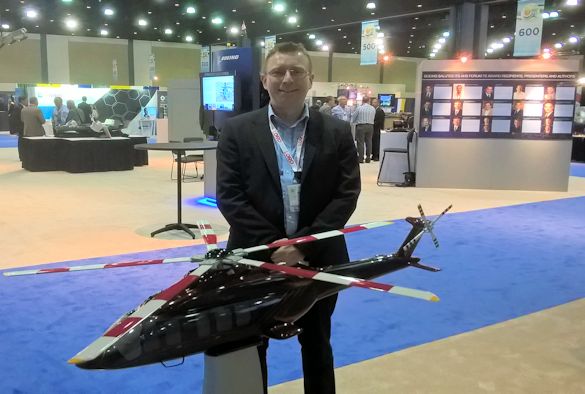Dr Michael Jump is a Senior Lecturer in the University School of Engineering’s Centre for Engineering Dynamics, working primarily in the Flight Science and Technology Research Group.
“I recently attended the American Helicopter Society (AHS) International’s 72nd Annual Forum and Technology Display in West Palm Beach, Florida.
The AHS International Forum is the world’s leading international technical event for those with a research interest in vertical flight technology. This year’s 3-day meeting included more than 250 technical papers on a wide range of disciplines ranging from Acoustics to Unmanned Systems.
Handling Qualities research activities
Aside from keeping up with the latest technical developments being reported, the purpose for the visit was two-fold. First, as a member of the AHS International Handling Qualities Technical Committee, I was required to attend the Committee meeting and report on Handling Qualities (HQ) research activities at the University of Liverpool.
Handling qualities are defined as those qualities or characteristics of an aircraft that govern the ease and precision with which a pilot is able to perform the tasks required in support of an aircraft role. As such, good handling qualities are critical in helping to ensure safe aerial operations.
I reported on additional progress made since the culmination of recent EU-funded projects on detecting, alleviating and preventing rotorcraft pilot couplings (http://aristotel-project.eu/) and on defining handling qualities parameters for personal aerial vehicles (http://www.mycopter.eu/). Committee members also attend the HQ sessions at the Forum to nominate and vote for the Best HQ Paper.
Autorotation landing algorithm
The second reason for the trip was to meet up with Dr Jonathan Rogers from the Georgia Institute of Technology (GIT) for a progress meeting. Dr Rogers and I have recently been awarded a small amount of seed corn funding to trial an autorotation landing algorithm designed for unmanned vehicles at GIT in manned flight situations.
If a helicopter suffers an engine or other catastrophic failure, the pilot can still ‘fly’ the aircraft to a safe landing by putting the rotor into an autorotative state. Here, rather than being driven the engine, the rotor extracts energy form the air to keep it spinning – this is analogous to a sycamore seed spinning as it falls from the tree.
However, the manoeuvre is difficult to enter successfully, requires good decision-making as to where to land and then a high degree of skill to flare the aircraft i.e. reduce the forward and vertical speed to ensure gentle contact with the ground.
HELIFLIGHT-R simulation facility
The project will use the University’s HELIFLIGHT-R simulation facility and will require the development of displays to assist the pilot to make the correct control inputs. It is envisaged that the combination of GIT algorithm plus UofL display system will ease pilot workload and increase the safety of such manoeuvres.
If the initial results look promising, then the project will receive more funding to develop the system further, adding in haptic feedback and further elements to the display to assist the pilot’s decision-making process.
Whilst at the Forum, Dr. Rogers and I met up with representatives from Boeing who have expressed an interest in the results of the work. I look forward to welcoming Dr Rogers to Liverpool in the Autumn to attend the planned flight simulation trials of the system.”
